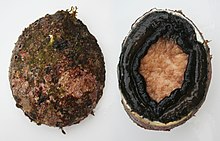Haliotis rubra
Haliotis rubra | |
|---|---|
 | |
Scientific classification | |
| Kingdom: | Animalia |
| Phylum: | Mollusca |
| Class: | Gastropoda |
Clade: | Vetigastropoda |
| Superfamily: | Haliotoidea |
| Family: | Haliotidae |
| Genus: | Haliotis |
| Species: | H. rubra |
Binomial name | |
Haliotis rubra W. E. Leach, 1814 | |
Synonyms | |
| |
The blacklip abalone, Haliotis rubra, is an Australian species of large, edible sea snail, a marine gastropod mollusk in the family Haliotidae, the abalones.[1][2]

Two shells of Haliotis rubra
Contents
1 Subspecies
2 Description
3 Distribution
4 References
5 External links
Subspecies
Haliotis rubra conicopora Péron, 1816 – the conical pore abalone; synonyms: Haliotis conicopora Péron, 1816 (original combination), Haliotis cunninghami Gray, 1826; Haliotis granti Pritchard & Gatliff, 1902; Haliotis vixlirata Cotton, 1943
Haliotis rubra rubra Leach, 1814 the shield abalone; synonyms: Haliotis ancile Reeve, 1846; Haliotis improbula Iredale, 1924; Haliotis naevosa Philippi, 1844; Haliotis ruber Leach, 1814 (original combination); Haliotis whitehousei (Colman, 1959); Sanhaliotis whitehousei Colman, 1959
Description
The size of the shell varies between 3.5 and 20 cm (1.4–7.9 in). "The large, much depressed shell has a rounded-oval shape. The distance of the apex from the margin is one-fifth the length of the shell. It is sculptured with fine spiral cords cut by close minute striae of increment. It shows radiating waves or folds above. A slight angle at the row of perforations, below it is broadly excavated and then carinated. The about six perforations are elevated and circular. The outline is suborbicular, much depressed and solid but not thick. The surface is either dark red with few radiating angular white patches, or dull red and green, streaked and mottled. The spiral cords of the outer surface are either nearly equal, or have slightly larger ones at wide intervals. They are decussated by close growth-striae. The whorls number a trifle over 3. Inside they are corrugated like the outer surface, silvery, and very brilliantly iridescent. The reflections are chiefly sea-green and red. The columellar plate is broad, flat, and obliquely truncated at its base. The cavity of the spire is wide, open, but shallow
This is a variable form, in color varying from dark coral red to dull red streaked with pale green." [3]
Distribution
This species is endemic to Australia, and is one of two species of abalone taken in South Australia and Tasmania (the other is the greenlip abalone).[4]
Range is from Fremantle, Western Australia, to Angourie, New South Wales, and around Tasmania.[5]
It is called the blacklip abalone because the edge of the foot is black.
Haliotis rubra with a kelp anchored on the shell
Haliotis rubra showing the characteristic black edge of the foot
Haliotis rubra frequently choose to shelter in fairly tight crevices
Two specimens of Haliotis rubra visible through a gap between two boulders
References
^ http://www.seashellsofnsw.org.au/Haliotidae/Pages/haliotis_rubra.htm
^ Bouchet, P. (2012). Haliotis rubra Leach, 1814. Accessed through: World Register of Marine Species at http://www.marinespecies.org/aphia.php?p=taxdetails&id=445354 on 2013-02-04
^ H.A. Pilsbry (1890) Manual of Conchology XII; Academy of Natural Sciences, Philadelphia, 1890 (described as Haliotis naevosa)
^ "Fisheries - Abalone". Government of South Australia, Primary Industries and Regions SA. Retrieved 2012-08-10..mw-parser-output cite.citation{font-style:inherit}.mw-parser-output q{quotes:"""""""'""'"}.mw-parser-output code.cs1-code{color:inherit;background:inherit;border:inherit;padding:inherit}.mw-parser-output .cs1-lock-free a{background:url("//upload.wikimedia.org/wikipedia/commons/thumb/6/65/Lock-green.svg/9px-Lock-green.svg.png")no-repeat;background-position:right .1em center}.mw-parser-output .cs1-lock-limited a,.mw-parser-output .cs1-lock-registration a{background:url("//upload.wikimedia.org/wikipedia/commons/thumb/d/d6/Lock-gray-alt-2.svg/9px-Lock-gray-alt-2.svg.png")no-repeat;background-position:right .1em center}.mw-parser-output .cs1-lock-subscription a{background:url("//upload.wikimedia.org/wikipedia/commons/thumb/a/aa/Lock-red-alt-2.svg/9px-Lock-red-alt-2.svg.png")no-repeat;background-position:right .1em center}.mw-parser-output .cs1-subscription,.mw-parser-output .cs1-registration{color:#555}.mw-parser-output .cs1-subscription span,.mw-parser-output .cs1-registration span{border-bottom:1px dotted;cursor:help}.mw-parser-output .cs1-hidden-error{display:none;font-size:100%}.mw-parser-output .cs1-visible-error{font-size:100%}.mw-parser-output .cs1-subscription,.mw-parser-output .cs1-registration,.mw-parser-output .cs1-format{font-size:95%}.mw-parser-output .cs1-kern-left,.mw-parser-output .cs1-kern-wl-left{padding-left:0.2em}.mw-parser-output .cs1-kern-right,.mw-parser-output .cs1-kern-wl-right{padding-right:0.2em}
^ Edgar, Graham J. (2008). Australian Marine Life: The plants and animals of temperate waters (Second ed.). Sydney: New Holland. ISBN 9781921517174.
- Wilson, B. 1993. Australian Marine Shells. Prosobranch Gastropods. Kallaroo, Western Australia : Odyssey Publishing Vol. 1 408 pp.
- Geiger, D.L. 2000 [1999]. Distribution and biogeography of the recent Haliotidae (Gastropoda: Vetigastropoda) world-wide. Bollettino Malacologico 35(5-12): 57-120
- Geiger D.L. & Poppe G.T. (2000). A Conchological Iconography: The family Haliotidae. Conchbooks, Hackenheim Germany. 135pp 83pls
- Geiger D.L. & Owen B. (2012) Abalone: Worldwide Haliotidae. Hackenheim: Conchbooks. viii + 361 pp.
External links
- New South Wales government fisheries info
- Gastropods.com info and shell images
| Wikimedia Commons has media related to Haliotis rubra. |




